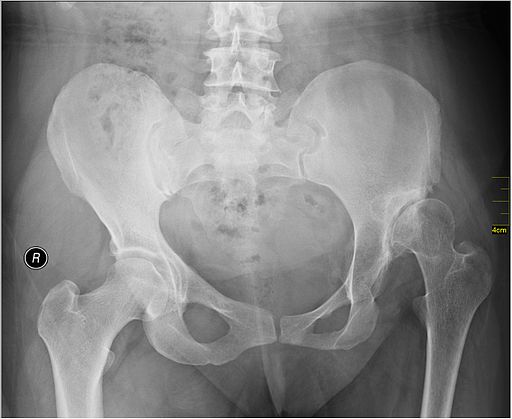Hip Joint Repair
Total Hip Replacement
Post-operative management of THA and hip fractures will be among the most commonplace services rendered by PTAs to members of the older adult and geriatric populations.
Approximate video length: 4 minutes
Link to this video for a demonstration of post-operative precautions common to a total hip replacement
Approximate video length: 8 minutes
Comparison of hip precautions
|
anterior & lateral approach |
No flexion >90 |
No extension |
No adduction |
No external rotation past neutral |
Avoid the combined motion of flexion abduction and external rotation |
|
posterior approach |
No flexion >90 |
|
No adduction |
No internal rotation |
|
|
lateral approach (specific) |
|
|
|
|
No SLR x 6 weeks No active abduction x 6 weeks |
|
anterior & lateral approach |
Do not cross legs |
Avoid low chairs; raise toilet seats
|
Avoid standing and rotating away from involved side |
Use step-to gait pattern |
|
posterior approach |
Do not cross legs |
Avoid low chairs; raise toilet seats |
Avoid standing and rotating toward involved side |
|
Understand precautions due to both surgical approach and in cases of THA use of cement or uncemented. You will likely encounter patients questioning their personal limitations when someone else in the gym with the same original pathology has different restrictions. It is necessary to be able to logically explain the reason for the difference, to assist them in adhering to their post-surgical instructions.
Clinical Pearl: Patients often do not fully appreciate precautions in both open and closed chain motions. Take time to quiz your patient on the "do's" and "dont's" during functional movements that require open chain motions (e.g., bed mobility) and closed chain motions (e.g., sit to stand). Could you effectively and efficiently educate a patient in how to demonstrate joint protection strategies during these sample activities? If not, now is the time to practice!
Dislocation occurs in less than 5% of cases, and less than 2% during first several months of rehabilitation. Posterior dislocation is most common, regardless of approach. Posterior approach has highest incidence of dislocation. A dislocation presents as a shortening of the involved leg that was not previously present, paired usually with positioning of ER and severe complaint of pain. Patient will be in extreme, unrelenting pain. Failed hip ORIF has a similar presentation. Report these changes immediately to the supervising PT and discontinue all treatment until further evaluation by the surgeon

.https://commons.wikimedia.org/wiki/File%3AMedical_X-Ray_imaging_KDX05_nevit.jpg
Anterior and lateral approaches have a lower dislocation risk. However, the abductors typically partially or completely disrupted during surgery. Patients are usually restricted to no SLR or no active abduction exercises for six (6) weeks.
Patients commonly present with Trendelenberg weakness patterns that require additional support during early gait training.
Excessive stress to healing abductors may result in tendon avulsion and permanent, irreparable injury.
Approximate video length: 2 minutes
.
ORIF
Close monitoring of patient-specific weight bearing restrictions is important. The surgeon decides and progresses weight bearing status and this is communicated in the chart as a "patient order".
Unlike THA, the integrity of the bone, its ability to heal, and the secondary soft tissue trauma typically results in slower gait progressions. Surgeons will generally not allow any hip muscles resistance training for 4-6 weeks.
Clinical Preparedness: If a patient asked you to explain why they can not start "using those bands" to help strengthen their leg, could you apply your knowledge of tissue healing and muscle function to respond appropriately? Try it! How do you know how well you were able to explain why resistance bands are not appropriate at this time?